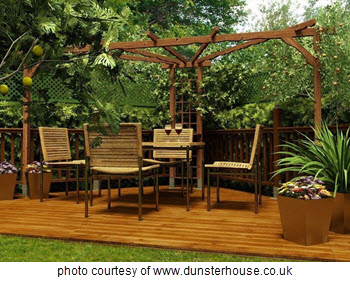Do your New Year’s resolutions include your yard?
We’ve talked with a number of homeowners around the Minneapolis area who are looking to do something new and different with their outdoor living spaces. We’d like to suggest something unique – a corner pergola.
 The shape, structure and material of a pergola determines what type of pergola it is classified as. There are always three features which are constant with corner pergolas, regardless of the type:
The shape, structure and material of a pergola determines what type of pergola it is classified as. There are always three features which are constant with corner pergolas, regardless of the type:
- open view
- flat roof
- location – on a corner of a deck, patio, or yard
Other outdoor installations can be similar, such as gazebo and pagoda. Both have a roof that is an inverted V-shape; the pergola’s constant that especially distinguishes it from these others is the flat roof.
Shape of Corner Pergola
There are three basic configurations of corner pergolas, with the triangular shape being the most basic one. Corner pergolas that are triangular in shape, have three sides, fitted into a corner against a wall, fence, or even a house, although they can be freestanding.
Another type is a semi-circular pergola, having one side curved, which looks like a slice cut out of a pie. The circular shape of the flooring and roof dictates the rounded shape.
The third design is an l-shape, with the pergola roof extending in two long rectangular sections out from the corner. The majority of the space created by this corner design is not covered. This type serves mostly to draw your attention to the corner spot, but it does provide some shade along the edges.
Materials for Corner Pergolas
A variety of different materials are used to make corner pergolas. The most common are wood, metal, and PVC or plastic molded resin.
- Most homeowners and landscape designers prefer the main material to be wood. There is a sense unity and a more earthier feel when a wood pergola is chosen.
- For a look which is contemporary and contrasting, chose metals such as steel or iron.
- When looking for a more affordable and weather-resistant choice, polyvinyl chloride and vinyl (PVC – often used for pipes) is a wise choice, due to it not rusting or decaying as much, when compared to wood and metal.
There are variations on this as well, with materials such as concrete or stone being incorporated into the supporting structure. The material you choose for your pergola should fit both with your home and your existing landscaping features.
Two Structures of Corner Pergolas
The structure of a corner pergola can be either side-walled one or free-standing. Usually there is a requirement of at least four posts needed for support of the pergola’s roof and to create its pergolas overall shape for a free-standing design. The other kind of structure for corner pergola is side-walled, there are two sides which have lattice or other types of panels installed, limiting the entryway to only one side. The side-walled design can also be used up against the corner of a home.
The uses of a corner pergola are almost endless. They are one of the best ways to turn an unused corner of your yard into a useful and attractive outdoor room. Corner pergolas are especially beautiful in smaller landscaped yards and can easily provide a defined outdoor room, even when there isn’t space for a larger rectangular or square pergola.
Speak with us at Architectural Landscape Design to begin planning today for a luxurious corner pergola of your own. With the planning process going now in the winter, you’ll be ready for springtime installation.
We are a licensed MN landscape design company, and we offer landscaping services in the Minneapolis and St. Paul area as well as other communities around Minnesota and western Wisconsin.
